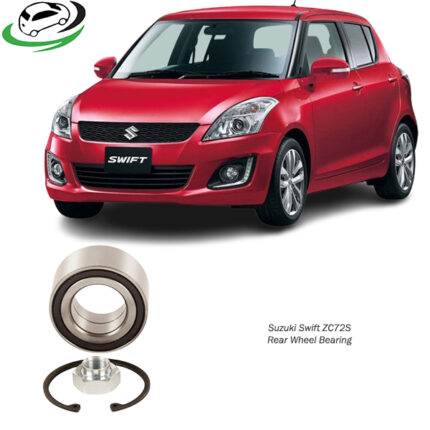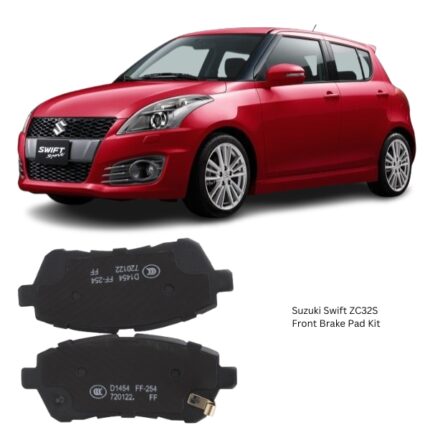Get Suzuki Swift ZC32S Front Brake Pad Kit D0051-M in Kenya
The Front Brake Pad Kit is a fundamental component of a vehicle’s disc braking system, engineered to deliver safe, consistent, and effective braking performance. It includes all necessary parts to replace the front brake pads, ensuring the restoration of optimal braking response, reduced noise, and extended component life. As the front brakes typically handle the majority of the braking load, regular maintenance and timely replacement of front brake pads are essential to both safety and vehicle performance.
This kit is a complete solution for professional technicians and DIY users seeking to replace worn or degraded brake pads, and it comes with components designed to meet or exceed original equipment (OE) standards.
Purpose and Function of Front Brake Pads
The front brake pads function as friction-generating components that press against the brake rotors to slow down or stop the vehicle. When the driver presses the brake pedal, hydraulic fluid transmits force to the brake caliper pistons, which then push the pads onto the spinning rotor. The friction generated between the pad surface and the rotor converts the vehicle’s kinetic energy into heat, thus slowing the vehicle down.
Front brake pads are subject to extreme stress, temperature changes, and wear due to their frequent use and the high braking loads they endure. This makes quality and condition crucial to safe vehicle operation.
Components of the Front Brake Pad Kit
A standard Front Brake Pad Kit typically includes:
-
A set of four brake pads (two inner and two outer) for both front wheels
-
Anti-rattle clips or shims
-
Pad wear indicators or sensors (where applicable)
-
Backing plates
-
Grease packs for noise reduction and proper installation (in some kits)
These elements work together to provide a secure, quiet, and vibration-free braking experience.
Construction and Materials
Front brake pads are constructed from layered materials designed for high performance, durability, and compatibility with modern braking systems.
Friction Material
This is the working surface that contacts the rotor. The material may include:
-
Semi-metallic compounds: Blend of metals, resins, and graphite—durable, with excellent heat dissipation.
-
Ceramic formulations: Quiet, low-dust, and thermally stable—ideal for smooth driving.
-
Organic (Non-Asbestos Organic or NAO): Made from resin, Kevlar, glass, and rubber—softer and quieter but with shorter life spans.
Backing Plate
Made of steel or other rigid metals, the backing plate supports the friction material and ensures even pressure distribution during braking.
Adhesives and Bonding
High-temperature adhesives secure the friction material to the backing plate. Some may also be riveted for additional security.
Shims and Clips
Multi-layer shims help dampen vibration and reduce noise. Clips secure the pads in the caliper and minimize movement under load.
Each of these components is built to withstand extreme temperatures and pressures while offering a long service life under normal driving conditions.
Performance Benefits
Installing a new Front Brake Pad Kit offers multiple advantages:
-
Enhanced Braking Efficiency:
New pads restore lost stopping power, reduce braking distance, and ensure safer driving. -
Reduced Noise and Vibration:
Shims and new hardware minimize squealing, grinding, or juddering often caused by worn components. -
Improved Brake Pedal Feel:
Replacing worn pads improves pedal responsiveness and helps maintain hydraulic system balance. -
Extended Rotor Life:
Quality pads wear evenly and gently on rotors, preventing premature scoring or warping. -
Cleaner Operation:
Low-dust materials help keep wheels cleaner and reduce environmental pollution. -
Consistent Friction Performance:
Pads maintain stable performance across a wide temperature range and under different load conditions.
Signs That Brake Pads Need Replacement
Recognizing the symptoms of worn brake pads helps prevent more serious braking system failures:
-
Squealing or screeching noise when braking
-
Grinding sounds, indicating friction material has worn down to the metal backing
-
Brake warning light illuminated (on some vehicles with wear sensors)
-
Increased stopping distance or spongy pedal feel
-
Visible pad wear—less than 3mm of friction material remaining
-
Pulling to one side during braking
-
Vibration or pulsing in the brake pedal
Regular inspection and proactive replacement of brake pads are key to maintaining braking system efficiency and safety.
Installation Overview
While the exact steps depend on the vehicle design, here’s a general outline of the front brake pad replacement process:
-
Lift and support the vehicle safely
-
Remove the front wheels
-
Unbolt and swing away the brake caliper (or remove it entirely)
-
Remove the old brake pads
-
Inspect and clean the caliper bracket
-
Install new hardware (clips, shims, etc.) from the kit
-
Apply brake grease to contact points if included
-
Insert the new brake pads
-
Compress the caliper piston to accommodate new pad thickness
-
Reinstall the caliper and torque to specifications
-
Reinstall wheels and lower the vehicle
-
Pump the brake pedal before driving to ensure proper engagement
After installation, it’s recommended to follow a brake pad bedding-in procedure to seat the pads properly. This involves performing a series of controlled stops to gradually heat and condition the pad surface.
Maintenance Tips
To maximize the lifespan and performance of front brake pads:
-
Inspect the braking system regularly—including calipers, rotors, and fluid
-
Avoid hard braking when cold—this causes uneven wear
-
Use appropriate brake fluid and change it periodically
-
Check pad wear visually or with wear sensors
-
Replace rotors or resurface them if worn or grooved
-
Maintain proper tire pressure to reduce uneven braking load
Timely pad replacement prevents rotor damage, preserves braking power, and keeps vehicle safety systems like ABS functioning properly.
Environmental and Safety Considerations
Modern brake pads are manufactured with low or no copper formulations and use eco-friendly friction materials to meet environmental standards. Proper disposal of old brake pads is also important, as some older pads may contain hazardous materials.
High-quality brake pads are rigorously tested for fade resistance, thermal stability, and noise performance, ensuring they perform reliably in emergency braking, heavy traffic, and long downhill descents.
Follow us on Facebook for more parts.




